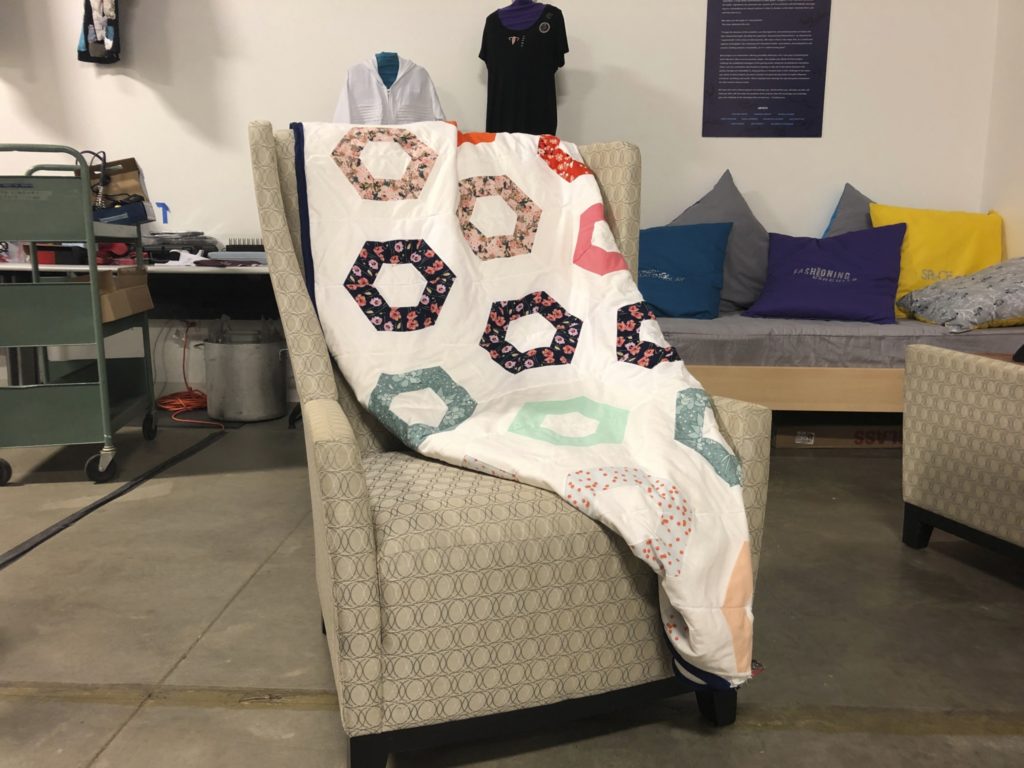By: Carlin Flores, Spring 2019
In the Spring semester of 2019, my Critical Making course with Dr. Kim Knight drove me to tackle the project I’d avoided for years: a full-size quilt. Marriam Webster defines a quilt as: “a bed coverlet of two layers of cloth filled with padding (such as down or batting) held in place by ties or stitched designs.” A brief definition for an impossibly lengthy process. Dubbed 10,003 Stitches, this quilt pushed me in ways I had never experienced and opened my eyes to a new world of making.


Quilting originated as a technique for furniture cushions and fancy clothing. The first recorded quilted bed blanket dates in early fourteenth century Sicily, with blocks depicting the Legend of Tristan and the inside padded with wool (Johnson). The early North American settlers brought their craft from Europe and while there are records and inventories that list quilts as possessions, no early colonial quilts survive (Johnson). This is mainly due to the origins of the quilts’ fabric coming from salvaged pieces and the need to get as much as possible out of the limited resources colonizers brought with them (Johnson). The importance of quilting ranged from the utility it brought the family as a source of warmth and comfort, to the emotional nourishment “quilting bee’s” gave the female crafters as a place of support and collaboration (Johnson).
My mother, grandmother (Grammy) and great-grandmother are quilters. Grammy is a part of her church’s quilt guild and they always have projects in the works. I saw Grammy and her quilt guild work on baby, graduation, wedding, and birthday quilts for each other’s loved ones in a fashion like the early quilting bee’s settler women participated in. Unbeknownst to the members, early and modern quilt guilds are feminist makerspaces where women can meet in safe, open contexts of shared values and goals. The chapter on feminist hackerspaces in Jentry Sayers’ Making Things and Drawing Boundaries details the characteristics of feminist makerspaces and the similarities are undeniable. The chapter’s contributors mark the importance of the work done in the spaces impacting the work outside of the space (Amu, et al.). The ladies of Grammy’s quilt guild not only support each other in mastering their craft, but also in their lives outside the guild in things as simple as sharing recipes to the grieving of a loved one. Their guild is a close knit and exclusive “secret society of practitioners” (Dick) and I have never truly been privy to one of their meetings.
I was drawn to the idea of a quilt, especially in the past couple years as I hoarded designer fabric and coed over finished projects I on social media, but I never committed to a pattern or color scheme. The soothing combinations of color and crisp lines concealed a staggering amount of labor and I was struck by the precision and permanence a quilt required to succeed. My current free-spirited, heavily improvised practice was not on board with all the painstaking care that goes into even the simplest of quilts. I knew a bad quilt could not be painted over and quilted mistakes are more obvious than those in a more traditional art media. The lazy perfectionist in me was terrified. But something about Dr. Knight’s Critical Making course demanded a quilt, and I knew I could put off the project no longer.
Before 10,003 Stitches, my experience with a sewing machine was limited to a sloppy table runner, an appliqué “cheater” quilt, and a light-up tote bag sewn a few weeks before I began the quilt itself. Armed with my mother’s sewing machine and facing a looming deadline, I set about my task. After countless hours leaning over a cutting mat or hunched at the sewing machine, I resolved to never make another quilt for as long as I live. I cursed my ambition and wondered how gracefully I could back out of the project and try something easier. It wasn’t until I laid out all my blocks and saw what my work could become that the lightbulb came on. All my hard work was coming to a satisfying end and I was giddy as I swapped blocks to get the perfect combinations. “I’m getting second-hand art high,” my roommate and best friend remarked as she watched me tiptoe around the colorful pieces on the living room floor.
Given the requirements of the course, my quilt could not be considered complete without first adding a technological component. “Critical Making” is a blanket term for many varied practices, but a common practice in critical making is reconciling a traditional craft with a modern context or technology. I chose to imbed vibrating motors in my quilt to increase the physical experience that comes with wrapping oneself up in a cozy blanket. The first motor buzzes in a sequence similar to a heartbeat because a quilt is a labor of love for the craft or the recipient of the quilt; the second motor makes 10 long buzzes for 10,000 stitches; the third makes 5 shorter buzzes to represent the stitches I had to rip and redo; the fourth makes 5 rapid buzzes to mirror the rushed anxiety I felt completing this project; and the fifth motor buzzes 3 short notes to represent the 3 stitches I received in the emergency room when I sliced my finger open with a brand new rotary cutter. The inclusion of the vibration motors lets the person using the quilt physically experience a part of the story of the quilt, as well as educating the user of how much the quilt cost in terms of hours and emotional stress. This allows me to imbed the theory and the story inside the quilt, instead of displaying it on the outside.
At some point in the process, I think as I was trying to reconcile my uneven novice blocks into something passable, I realized I was part of the problem: I completely underestimated the craft, what it took to make a quilt from start to finish, and the emotional and physical labor involved. I was a fool to think I knew anything about making a quilt simply because I knew quilters; you don’t know a thing about quilting until you plead with a machine to thread its bobbin after countless failed attempts or redo an unmatched seam for the third time, all while a dense rage bubbles in your chest. I am sure these are problems anyone that works with fabric or a sewing machine can attest to, but the sheer volume of cutting, matching, sewing, ironing, cutting, matching, sewing, ironing, cutting- to produce one block of sixty- was ridiculous. I misjudged the required materials and ran out of my fancy printed fabric while I was still 2 blocks short of each design. I ended up improvising some coordinating blocks out of solid colors and luckily, it turned out.
At this point, I had to realize I wasn’t taking my own work seriously. I had to shake the voice in my head telling me I would get back to my “real” art once I finished this little craft project. Like so many stuffy artists before me, I struggled with the delineation between “art” and “craft.” Christine and Margaret Wertheim’s Crochet Coral Reef is a beautiful book that captures the worldwide collaborative project made by hundreds of knitters and fiber artists. The chapter “Reverie as Resistance” by Leslie Dick investigates the historical dismissal of women’s handicraft. Knitting, crochet, embroidery, quilting, etc. are lengthy processes that are usually driven by instructions and repetitive motions. In an art world run primarily by cisgendered, white, affluent males, the craft of women doesn’t make it very far. The crafts are typically seen as a waste of time, or not theory-dense enough to warrant higher accolades. Dick argues that it is the time spent in the craft, for the sake of the craft, that makes the objects art. “Wasted” time enjoying the process of making a “more or less unnecessary item,” inherently adds value to the work. Buying a machine-made blanket or sweater is a far wiser use of time and money but hitting the “Place Order” button will never feel as good as making does.
For all my moaning, the process of making this quilt was not all terrible. The satisfaction of seeing the pile of blocks grow was gratifying, even fun, as I found my rhythm and a process that worked. I believe I even experienced the “reverie” Leslie Dick mentions in her chapter in Crochet Coral Reef. Reverie is a daydream-like state of mind often experienced by people that perform a repetitive motion for extended periods of time. Practitioners of traditionally feminine handiwork experience it frequently as they work, and I know I slipped into that state of mind as I pieced my blocks together. The state of reverie is important to the creative process because it allows the brain to “idle” on an idea while still being active. The reverie allowed me to reflect on the quilt as an object and what it could mean to me, instead of being absorbed in my life outside of the quilt. I also considered my future projects, the corners I could not cut, and I gained a new appreciation for Grammy’s masterful works that took years to my short months.
I grew up looking at Grammy’s best quilts stored in a glass case, and today I see her knurled hands, so taken with arthritis after decades of hand stitching that I wonder about the fate of my own hands in the years to come… At this point I welcome the arthritis as an occupational hazard that comes with being a maker. The process was long and frustrating, but I am filled with pride when I see my quilt and it will become a cherished object in my home, as should any handmade item in any space.
Works Cited:
- Burek, Amu, et al. “Chapter 25.” Making Things and Drawing Boundaries Experiments in the Digital Humanities, by Jentery Sayers, University of Minnesota Press, 2018, pp. 221–231.
- Dick, Leslie. “Reverie as Resistance” Crochet Coral Reef: a Project, by Margaret Wertheim and Christine Wertheim, Institute for Figuring, 2015, pp. 129–136.
- Johnson, Julie. “HISTORY OF QUILTING.” Emporia State University, www.emporia.edu/cgps/tales/quilte~1.html.
- https://www.merriam-webster.com/dictionary/quilt
